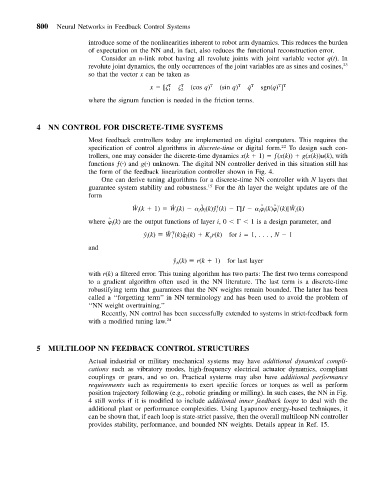Page 809 - Mechanical Engineers' Handbook (Volume 2)
P. 809
800 Neural Networks in Feedback Control Systems
introduce some of the nonlinearities inherent to robot arm dynamics. This reduces the burden
of expectation on the NN and, in fact, also reduces the functional reconstruction error.
Consider an n-link robot having all revolute joints with joint variable vector q(t). In
revolute joint dynamics, the only occurrences of the joint variables are as sines and cosines, 23
so that the vector x can be taken as
T T
x [ T 1 T 2 (cos q) T (sin q) T ˙ q T sgn(q)]
where the signum function is needed in the friction terms.
4 NN CONTROL FOR DISCRETE-TIME SYSTEMS
Most feedback controllers today are implemented on digital computers. This requires the
specification of control algorithms in discrete-time or digital form. 22 To design such con-
trollers, one may consider the discrete-time dynamics x(k 1) ƒ(x(k)) g(x(k))u(k), with
functions ƒ( ) and g( ) unknown. The digital NN controller derived in this situation still has
the form of the feedback linearization controller shown in Fig. 4.
One can derive tuning algorithms for a discrete-time NN controller with N layers that
guarantee system stability and robustness. 15 For the ith layer the weight updates are of the
form
ˆ
ˆ
ˆ
T ˆ
ˆ
ˆ
T
W (k 1) W (k)
(k)ˆy (k) I
(k) (k) W (k)
i
i
i
i
i
i
i
i
i
ˆ
where (k) are the output functions of layer i,0 1 is a design parameter, and
i
ˆ
T
ˆ y (k) W (k)ˆ (k) Kr(k) for i 1,..., N 1
i i i v
and
ˆ y (k) r(k 1) for last layer
N
with r(k)a filtered error. This tuning algorithm has two parts: The first two terms correspond
to a gradient algorithm often used in the NN literature. The last term is a discrete-time
robustifying term that guarantees that the NN weights remain bounded. The latter has been
called a ‘‘forgetting term’’ in NN terminology and has been used to avoid the problem of
‘‘NN weight overtraining.’’
Recently, NN control has been successfully extended to systems in strict-feedback form
with a modified tuning law. 24
5 MULTILOOP NN FEEDBACK CONTROL STRUCTURES
Actual industrial or military mechanical systems may have additional dynamical compli-
cations such as vibratory modes, high-frequency electrical actuator dynamics, compliant
couplings or gears, and so on. Practical systems may also have additional performance
requirements such as requirements to exert specific forces or torques as well as perform
position trajectory following (e.g., robotic grinding or milling). In such cases, the NN in Fig.
4 still works if it is modified to include additional inner feedback loops to deal with the
additional plant or performance complexities. Using Lyapunov energy-based techniques, it
can be shown that, if each loop is state-strict passive, then the overall multiloop NN controller
provides stability, performance, and bounded NN weights. Details appear in Ref. 15.

